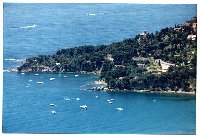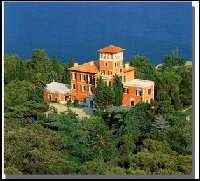
![]()
![]() Italy Hotels and Restaurants, Alberghi e
Ristoranti in Italia, Auberges et Restaurants en Italie....
Italy Hotels and Restaurants, Alberghi e
Ristoranti in Italia, Auberges et Restaurants en Italie....![]()

|
Giardini Botanici Villa Hanbury Ventimiglia (IM)
The Hanbury Botanical Gardens |
|
||
|
The Hanbury Botanical Gardens were created in 1867, when Sir Thomas Hanbury, holidaying on the Côte d'Azur, was struck by the beauty of Cape Mortola, near Ventimiglia, and purchased eighteen hectares of a pastureland zone, bounded on three sides by mountains and washed by a flawless sea. As Sir Thomas had much travelled, especially in the Far East, he thought of transforming this small area into a complex to receive exotic plants from different countries, aided by his brother Daniel, an English pharmacologist. Skilful botanists were called from Germany, exchanges were organized of gardeners and scholars abroad, especially with the Kew Gardens, and special zones were created to group plants gathered together for their phytogeographic or ecological or aesthetic peculiarities. This criterium inspired the creation of the Japanese Garden, the Australian Forest, the collection of roses, that of succulent plants, the Garden of Perfumes and many other special areas. Among the numerous Italian and foreign gardens which may be visited today the Hanbury Botanic Gardens occupy quite a special place. They represent in fact, an exceptional acclimatization area where exotic plants from all over the world grow together in the open air, though out of their natural environment. It is this wonderful "cohabitation" which makes the charm of the Hanbury Botanical Gardens: as seasons change, the Gardens display a range of colours and forms such as only Nature can offer. |
|
Questa pagina è stata curata da: Antonello Rotondaro |
|
|

